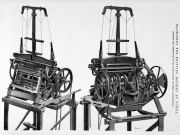Arthur Paget
Arthur Paget (1832-1895)
1870 Arthur Paget's knitting machine described and illustrated in 'Engineering'[1]
1895 Obituary [2]
ARTHUR PAGET was born at Leicester on 15th October 1832.
In 1848 he became a student in the applied sciences department at Kings' College, London, remaining there three years, and then served his pupilage of three years with Messrs. Sharp, Stewart, and Co., Manchester.
In 1854 he went to Loughborough, and was for two years engineer and manager, and for five years managing partner, in the firm of Messrs. Paget and White.
In 1866 he started business there on his own account as an engineer and machinist, taking up a branch of engineering to which some of his ancestors had devoted much attention — the manufacture of knitting, weaving, and other textile machinery; and many improvements of more or less importance are due to his inventive powers.
In 1870 he introduced his self-acting machine for knitting hosiery by steam power, of which lie gave account in a paper read at the meeting of this Institution in Nottingham (Proceedings 1870, page 127). The success attained with this knitting machinery encouraged bins still further in his experiments towards the constructions of the machine for warts weaving and knitting without weft, which was produced and shown at the Paris Exhibition in 1889, and was described at the Paris meeting in that year (Proceedings 1889, page 469). The mechanical ingenuity displayed, and the extreme accuracy and precision of the workmanship, were highly appreciated, and gained for him the decoration of Chevalier of the Legion of Honour.
The research work conducted by this Institution had its origin largely in his initiative; and for the investigation of the hardening of steel he undertook in 1881, in connection with Sir Frederick Abel, a series of tests to determine thoroughly the difference in percentage of carbon between samples of steel annealed or hardened by different processes, and also to ascertain with more precision how far the separation of the carbide in different preparations was an indication of different temper in the steel (Proceedings 1881, pages 696-9; 1882, pages 147-9; and 1885, pages 30, 49, 54).
Subsequently he made 900 experiments to ascertain the proper co-efficient of friction of various sorts of ropes on pulleys under different circumstances; but the results, even under similar conditions, were too varying to tabulate or admit of deductions.
He was one of the first and most vigorous promoters of the movement for transferring the headquarters of this Institution from Birmingham to London, the removal being ultimately carried out in 1877.
For some years past he had not enjoyed good health, and recently had suffered from a stroke of paralysis, which affected his speech and deprived him of the power of one side, his heart being also affected.
His death occurred from apoplexy on 25th March 1895, at the age of sixty-two.
He became a Member of this Institution in 1868, and was a Member of Council from 1878 to 1886, and a Vice-President from 1887 to 1891.
1895 Obituary [3]
See Also
Sources of Information
- ↑ [1] Engineering 23 Dec 1870
- ↑ 1895 Institution of Mechanical Engineers: Obituaries
- ↑ Engineering 1895 Jan-Jun: Index: General Index


